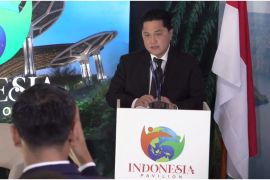“The consumption of protein from seafood, such as fish, shrimp, and crabs, is closely related to the existence of mangrove forests as spawning grounds for marine life," director general of sustainable forest management at the Environment and Forestry Ministry, Agus Justianto, said, according to a statement released on Tuesday.
In coastal ecosystems, mangroves act as producers that are favored by small fish, shellfish, and crabs. Many animals depend on them for food, eating parts of mangrove plants for their survival.
A healthy mangrove is a blessing for coastal communities because that means they can harvest fish, shellfish, and crabs. When bad weather prevents them from sailing upon the seas, the mangrove forest becomes an alternative source of food.
In addition to serving as a source of proteins, mangroves processed into products, such as syrups, dodol (snacks), chips, coffee, to skin care products, can also help meet the needs of vitamins and minerals.
“The protection and restoration of mangroves will not only improve the availability of fishery resources, but also improve the quality of coastal waters, as well as increase the availability of alternative sources of livelihood, such as ecotourism, that can improve people's welfare," Justianto said.
Related news: Mangrove ecosystem can store carbon for thousands of years: BRGM
Based on data from One Map Mangrove Indonesia, which serves as the basis for government programs, there are 3.3 million hectares of mangroves in Indonesia, making it the country with one of the largest mangrove ecosystems globally.
Indonesia’s mangroves account for 20 percent of the world's total mangrove area of 16.53 million hectares.
The government is committed to restoring and protecting mangroves along the Indonesian coastline. The government, through the Peat and Mangrove Restoration Agency, is targeting mangrove rehabilitation over an area of 600 thousand hectares, as envisaged by the 2020–2024 Medium-Term Development Plan.
Nine provinces have been included in the rehabilitation program—North Sumatra, Bangka Belitung, Riau, Riau Islands, West Kalimantan, East Kalimantan, North Kalimantan, Papua, and West Papua.
Related news: Ministry invites business sector to contribute to mangrove restoration
Related news: Mangrove forests have huge blue carbon potential: ministry
Translator: Sugiharto P, Mecca Yumna
Editor: Suharto
Copyright © ANTARA 2022











